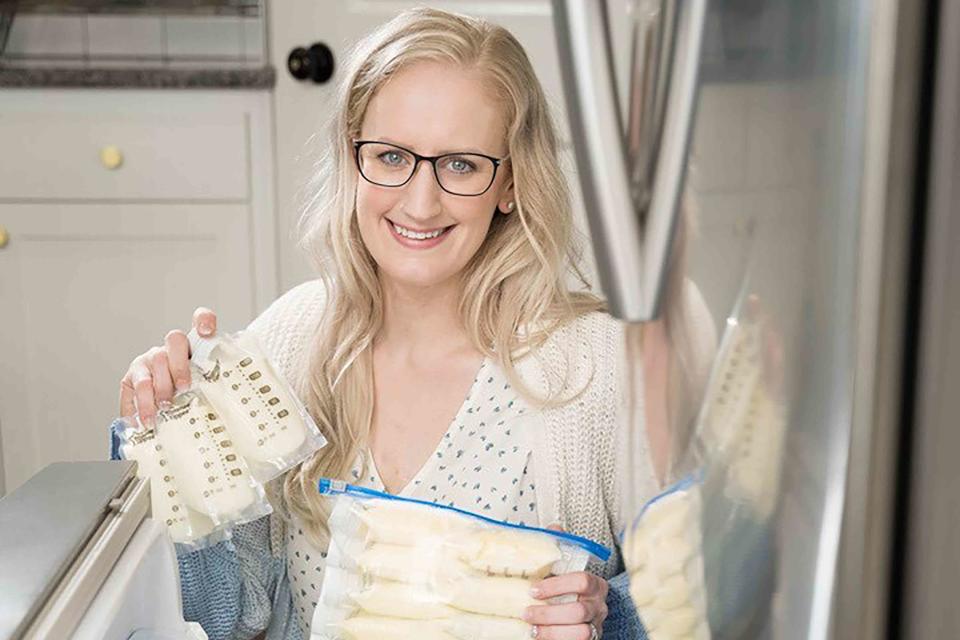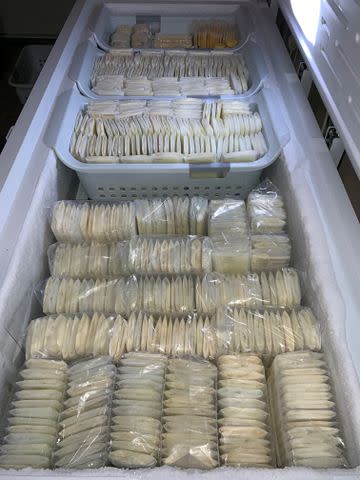Mom Sets Record For Donated Breast Milk—Enough to Fill 2,253 Venti Starbucks Cups
But is there a such thing as making too much human milk?

BabyBuddha
Fact checked by Sarah ScottMedically reviewed by Iya Mystique Hargrove, M.S., CFSD, CBS, CLE, CBE
Elisabeth Anderson-Sierra hoped to be able to breastfeed her first child when she found out she was pregnant about eight years ago. She had no idea she would wind up feeding thousands of other babies or become the Guinness Book of World Record holder for the largest donation of human milk by one person, a mark confirmed in July for the milk she donated to a bank between February 20, 2015, and June 20, 2018.
Anderson-Sierra, a native of Oregon, donated 1,599.68 liters of milk. That's enough to fill 2,253 Venti Starbucks cups. And she's still making milk for other babies, as well as her own 8-month-old. She now produces 200 ounces daily. The average human milk-fed infant consumes about 24 to 30 ounces per day.
Anderson-Sierra noticed something was different in the second trimester of her first pregnancy when she began producing 20 ounces of milk daily. There’s a common misconception that milk “comes in” within days of a baby's birth. But a pregnant person begins making milk in the second trimester, so it’s not unheard of for someone to notice some leaking milk. But 20 ounces daily? That’s rare.
“I think my midwife was talking about milliliters,” Anderson-Sierra says. ”I think as a first-time mom, there was a thought that I didn’t know what I was talking about.”
Anderson-Sierra’s condition, hyperlactation syndrome, also isn’t discussed much, and she understands it is rare. She’s not on a mission to normalize it. But she is on a mission to help parents reach their feeding goals, including letting them know that making “just enough” is completely perfect for their babies. Experts agree and believe it’s essential for parents to understand the definition, causes, and risks of hyperlactation so they don’t self-induce it.

Elisabeth Anderson-Sierra
What Is Hyperlactation?
In the simplest terms, “It’s making more milk than what a baby needs,” says Maria R Fisher, CNM, MPH, IBCLC, a midwife with Stony Brook Medicine who established a breastfeeding medicine clinic on Long Island (NY) to assist lactating parents in 2014.
But it gets a bit more complicated than that.
Typical Milk Supply
Before delving further into hyperlactation, it’s important to establish generally what a typical milk supply looks like. Experts, including Anderson-Sierra and Fisher, fear that people see photos of freezers full of human milk and think they are not making enough.
“Instagram is doing a number on women,” Fisher says. “They have this expectation that they need all this milk in the freezer, and that is not the case.”
A typical milk supply will vary throughout a person’s journey, particularly in the first few weeks of life, says Andrea L. Braden, MD, FACOG, IBCLC, a breastfeeding medicine specialist and CEO and co-founder of Lybbie.
“Healthy newborns need—and can only ingest—very small amounts of colostrum in the first few days of life,” Dr. Braden says. “Transitional milk is the first milk that is produced after [colostrum].”
Though it can vary, mature milk production begins around two weeks postpartum. Ultimately, Fisher says the general rule of thumb is to produce an ounce an hour or 24 ounces daily. Need a visual?
“It’s about the size of a bottle of wine,” Fisher laughs.
When direct nursing, parents don’t know precisely how much an infant takes, and Fisher says it will likely vary from feed to feed. She says that they are getting enough if the baby is gaining weight on their curve and producing plenty of wet and dirty diapers.
An international board-certified lactation consultant (IBCLC) can help parents address concerns about supply.
“If your IBCLC determines that you have either low supply or oversupply, they will provide you with a plan to address those concerns,” says Chrisie Rosenthal, IBCLC of The Lactation Network, a service in part that helps link parents to lactation consultants, including ones covered by insurance.
Hyperlactation supply
Hyperlactation is understudied and not clearly defined. One 2007 paper concurred. “Whereas underproduction is widely discussed in the lactation literature, overabundant milk supply is not,” wrote Caroline GA van Veldhuizen-Staascorre.
A 1996 report suggests that 15% of mothers may overproduce—but it's important to note it’s been nearly three decades since that was published. Not much has advanced in the way of studying hyperlactation in the years since.
“There is no agreed-upon set of criteria used to diagnose oversupply,” Rosenthal says. “Generally speaking, it's considered oversupply when a parent produces significantly more milk than what is required to feed their baby.”
But there’s no standard. There is a difference between producing 30 ounces daily when a child needs 24 ounces versus 50 ounces, let alone 200.
“When you get into 20 ounces more what the baby needs, now you’re talking about someone who is making enough for two babies, not one baby,” Fisher says. “If she has twins, that’s another story. We don’t have a number definition.”
What Causes Hyperlactation?
The Academy of Breastfeeding Medicine (ABM) lists three causes of hyperlactation:
Self-induced. This reason for hyperlactation is caused by behaviors such as overpumping after feeds or taking herbal substances and prescription medication. One of them is domperidone, a gastrointestinal medication that can increase milk production but is not approved for use in the U.S. by the Food and Drug Administration (FDA).
Iatrogenic. This hyperlactation cause occurs when health professionals play a role in the overproduction of human milk, such as instructing a lactating person to excessively pump after a baby has taken enough via direct nursing or taking galactagogues.
Idiopathic. This term describes lactating people who produce high levels of milk without a clear cause.
Fisher says it can also be because of underlying medical issues, such as a pituitary tumor or thyroid conditions that cause a person to overproduce prolactin, the hormone responsible for milk production and, therefore, human milk.
Such is the case with Anderson-Sierra. Bloodwork and imaging revealed she had an enlarged pituitary gland, which triggered excess milk production.
Anderson-Sierra says she was diagnosed with hyperlactation syndrome, which she says is different from people who “hyperlactate” due to lactation management, such as overpumping. However, the ABM groups all forms of hyperlactation under one umbrella.
Though the ABM does not differentiate between Anderson-Sierra’s condition and self-induced hyperlactation, one IBCLC agrees that the two causes are absolutely different.
Lactating involves a supply-and-demand feedback loop. The more a body is told to make milk by an infant or pump, the more it will make. So, if a parent pumps after every feed, they send a message to their body.
“The body receives programming early on, and the prolactin milk-making hormones levels are driven up artificially by all the stimulation and extra milk removal,” says Sheila Janakos, MPH, IBCLC, LE, RLC, the CEO and co-founder of Healthy Horizons Corporate Lactation Programs and Breastfeeding Centers. “Since the demand is higher, the body then gets programmed to produce extra milk.”
Anderson-Sierra’s medical origin adds a wrinkle—and more than 150 excess ounces. “The amounts of milk that is produced can be staggering and well beyond the needs of even triplets,” Janakos says.

BabyBuddha
Risks of Hyperlactation
Sometimes, people can struggle to make enough milk, or they make “just enough” and feel it’s “not enough,” particularly when they see freezers full of milk like Anderson-Sierra’s. But she says she has experienced considerable pain, spends hours daily pumping, and is still feeling the effects from a bout of mastitis, a painful infection, from early this summer. Experts and literature from the Academy of Breastfeeding Medicine suggest these are all common risks of hyperlactation.
According to the ABM, potential issues stemming from hyperlactation for the parent include:
Recurrent mastitis
Recurrent blocked ducts
Breast or nipple pain
Milk leakage
Early weaning
Switching to exclusive pumping
Concerns for the infant include:
Difficulty latching, particularly due to a forceful letdown
Choking, coughing, or unlatching during feeds
Breast/chest refusal
Reflux, spitting up, explosive green stools, and other gastrointestinal issues
Hyperlactation Treatments
The best way to treat hyperlactation is to prevent it from happening in the first place (when possible).
“It is best to let an infant regulate the supply by watching feeding cues and feeding when the infant is hungry,” says Dr. Braden. “Unless there is an issue such as a tongue tie, latching issue, or prematurity, typically it is best to stay away from the pump for at least three to four weeks so the body can adjust and not overproduce.”
Though the ABM may not differentiate between Anderson-Sierra’s condition and self-induced oversupply, the distinctions particularly matter when treating overproduction should it happen. If the surplus is self-induced or iatrogenic (behavioral), Fisher says lactating parents tend to take measures that continue to feed into excessive milk production.
“The tendency is to pump to empty the breast,” Fisher says. “What are you doing? You are emptying them and telling the body to make more.”
Parents may also attempt to apply tons of pressure as they massage the breast or chest area, which causes more discomfort and leads them to reach for the pump, and the cycle continues.
“We need to apply ice and feed the baby at the breast as much as possible,” Fisher says. “If, for some reason, we can’t feed the baby because we are not with the baby or the baby is not able to latch, you are going to remove only what the baby needs and enough to relieve the pressure. The key is not to empty the breast. Then, apply ice after.”
Light massages may also provide relief. Fisher says medications like Pseudofed, cabergoline, and estrogen birth control can also help reduce milk production. A parent should work with a health care team to map out strategies if the issue is medical.
“If it were due to a pituitary tumor, medication or even a possible surgery might be suggested,” Janakos says. “Most people, at that point, would be working with a board-certified endocrinologist, who would be managing the case.”
Anderson-Sierra says she’s tried the medications, and reducing pumping didn’t help because her issue wasn’t behavioral. Instead, at some point, she’ll likely opt for a double mastectomy to shut down milk production.
“I’ve exhausted other options,” Anderson-Sierra says. “I don’t react well to medications, and this drastic measure is kind of terrifying. It’s definitely not what I want, and I’m still trying to wrap my head around it and start my steps to consider it. What I do [currently] is not physically or mentally sustainable for the rest of my life.”

BabyBuddha
Silver Linings and a Message to Parents
Anderson-Sierra’s journey has been physically and mentally painful. But she’s happy she was able to feed all three of her children human milk, as well as thousands of other babies. She also started an online community, One Ounce at a Time, where she’s been able to provide pumping advice to parents and aid in informal milk sharing.
She became a certified lactation consultant and joined the team at BabbyBuddha as the director of lactation services, a full-circle moment because the company developed the lactation pump she uses. She hopes to help inform new products, such as enhanced suction strength, to help lactating parents, who often need to pump early in their journeys because of the lack of federal paid leave in the U.S.
She also constantly fields questions about supply — and how to build a freezer like hers.
“Moms leave comments like, ‘I pump and only get 5 oz,’” Anderson-Sierra says. “Basically, comments that put them down and put their journey down…I see it all day long. It breaks my heart a lot. I don’t want my pictures or story to have that kind of an impact.”
She responds to those comments as soon as she sees them.
“I quickly comment back that 5 ounces is perfect,” Anderson-Sierra says. “That is so amazing...Whatever you are doing matters. It is beautiful, and you’re doing it for your journey. We’re all so unique and going to look so many different ways. Be proud of your journey no matter what it looks like.”
Related: 7 Benefits of Extended Breastfeeding
For more Parents news, make sure to sign up for our newsletter!
Read the original article on Parents.

